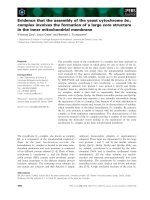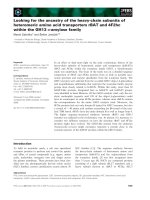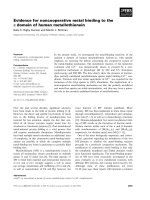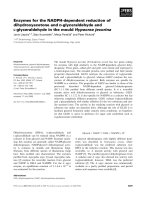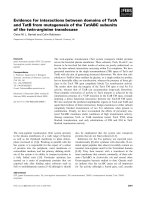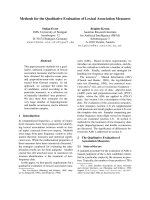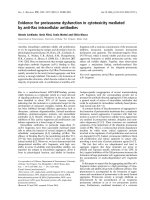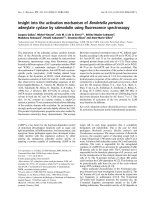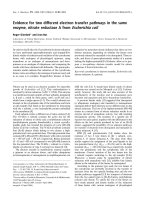Báo cáo khoa học: Evidence for the slow reaction of hypoxia-inducible factor prolyl hydroxylase 2 with oxygen pptx
Bạn đang xem bản rút gọn của tài liệu. Xem và tải ngay bản đầy đủ của tài liệu tại đây (473.33 KB, 11 trang )
Evidence for the slow reaction of hypoxia-inducible factor
prolyl hydroxylase 2 with oxygen
Emily Flashman
1
, Lee M. Hoffart
2
, Refaat B. Hamed
1,3
, J. Martin Bollinger Jr
2
, Carsten Krebs
2
and
Christopher J. Schofield
1
1 Department of Chemistry and Oxford Centre for Integrative Systems Biology, Oxford, UK
2 Department of Chemistry and Department of Biochemistry and Molecular Biology, The Pennsylvania State University, University Park,
PA, USA
3 Department of Pharmacognosy, Faculty of Pharmacy, Assiut University, Egypt
Keywords
2-oxoglutarate; hypoxia-inducible factor;
oxygen; oxygenase; prolyl hydroxylase;
spectroscopy
Correspondence
C. J. Schofield, Department of Chemistry
and Oxford Centre for Integrative Systems
Biology, 12 Mansfield Road,
Oxford OX1 3TA, UK
Fax: +44 1865 275674
Tel: +44 1865 275625
E-mail: christopher.schofield@chem.
ox.ac.uk
C. Krebs and J. M. Bollinger Jr.,
Department of Chemistry and Department
of Biochemistry and Molecular Biology,
The Pennsylvania State University,
University Park, PA16802, USA
Fax: +1 814 865 2927
Tel: +1 814 865 6089
E-mail:
and
Fax: +1 814 863 7024
Tel: +1 814 863 5707
E-mail:
(Received 10 June 2010, revised 29 July
2010, accepted 2 August 2010)
doi:10.1111/j.1742-4658.2010.07804.x
The response of animals to hypoxia is mediated by the hypoxia-inducible
transcription factor. Human hypoxia-inducible factor is regulated by four
Fe(II)- and 2-oxoglutarate-dependent oxygenases: prolyl hydroxylase
domain enzymes 1–3 catalyse hydroxylation of two prolyl-residues in
hypoxia-inducible factor, triggering its degradation by the proteasome. Fac-
tor inhibiting hypoxia-inducible factor catalyses the hydroxylation of an
asparagine-residue in hypoxia-inducible factor, inhibiting its transcriptional
activity. Collectively, the hypoxia-inducible factor hydroxylases negatively
regulate hypoxia-inducible factor in response to increasing oxygen concen-
tration. Prolyl hydroxylase domain 2 is the most important oxygen sensor in
human cells; however, the underlying kinetic basis of the oxygen-sensing
function of prolyl hydroxylase domain 2 is unclear. We report analyses of
the reaction of prolyl hydroxylase domain 2 with oxygen. Chemical
quench ⁄ MS experiments demonstrate that reaction of a complex of prolyl
hydroxylase domain 2, Fe(II), 2-oxoglutarate and the C-terminal oxygen-
dependent degradation domain of hypoxia-inducible factor-a with oxygen to
form hydroxylated C-terminal oxygen-dependent degradation domain and
succinate is much slower (approximately 100-fold) than for other similarly
studied 2-oxoglutarate oxygenases. Stopped flow ⁄ UV-visible spectroscopy
experiments demonstrate that the reaction produces a relatively stable spe-
cies absorbing at 320 nm; Mo
¨
ssbauer spectroscopic experiments indicate
that this species is likely not a Fe(IV)=O intermediate, as observed for other
2-oxoglutarate oxygenases. Overall, the results obtained suggest that, at least
compared to other studied 2-oxoglutarate oxygenases, prolyl hydroxylase
domain 2 reacts relatively slowly with oxygen, a property that may be asso-
ciated with its function as an oxygen sensor.
Structured digital abstract
l
MINT-7987711: PHD2 (uniprotkb:Q9GZT9) enzymaticly reacts (MI:0414) CODD
(uniprotkb:
Q16665)byenzymatic study (MI:0415)
Abbreviations
CODD, C-terminal oxygen-dependent degradation domain; HIF, hypoxia-inducible factor; NODD, N-terminal oxygen-dependent degradation
domain; 2OG, 2-oxoglutarate; PHD2, prolyl hydroxylase domain 2; TauD, taurine 2OG dioxygenase.
FEBS Journal 277 (2010) 4089–4099 ª 2010 The Authors Journal compilation ª 2010 FEBS 4089
Introduction
The cellular response of animals to hypoxia is medi-
ated by a heterodimeric transcription factor, hypoxia-
inducible factor (HIF) [1]. Under hypoxic conditions,
HIF up-regulates an array of genes, including those
encoding vascular endothelial growth factor and eryth-
ropoietin [2–4], which work to counteract the effects of
hypoxia. Levels of HIF-a, but not HIF-b, are regulated
directly by oxygen availability [5]. Prolyl-4-hydroxyl-
ation in either of the N- or C-terminal oxygen-depen-
dent degradation domains [Pro402 of N-terminal
oxygen-dependent degradation domain (NODD) and
Pro564 of C-terminal oxygen-dependent degradation
domain (CODD)] of HIF-a increases its binding to the
von Hippel Lindau protein elongin C ⁄ B complex,
which targets HIF-a for proteasomal degradation [6,7].
In a separate oxygen-dependent mechanism of HIF
regulation, asparaginyl hydroxylation (Asn803) in the
HIF-a C-terminal transactivation domain reduces the
interaction of HIF with transcriptional coactivators [8].
HIF hydroxylation is catalysed by Fe(II)- and 2-oxo-
glutarate (2OG)-dependent oxygenases. In human cells,
there are three prolyl hydroxylase domain enzymes 1–3
(PHDs 1–3), which have significant homology in their
catalytic domains [9–11], and one asparaginyl hydroxy-
lase, termed factor inhibiting HIF (FIH) [12,13]. On
the basis of evidence obtained from cell cultures and
mouse models [14,15], prolyl hydroxylase domain 2
(PHD2) has been identified as the most important of
the HIF hydroxylases for the hypoxic response in nor-
mal human tissues.
Fe(II) ⁄ 2OG-dependent oxygenases constitute a ubiq-
uitous family of enzymes that perform a range of
biologically important oxidation reactions [16]. It is
proposed that most 2OG-dependent oxygenases employ
a conserved reaction mechanism [17–20] (Fig. 1), which
has been adapted from that proposed for the collagen-
modifying prolyl-4-hydroxylase [21]. Evidence for this
mechanism stems from detailed crystallographic and
spectroscopic analyses of the stable Fe(II)-containing
intermediates, as well as the characterization of reac-
tion intermediates, including the Fe(IV)=O complex
and the Fe(II) product complex, by a combination of
rapid kinetic and spectroscopic methods [22]. The
Fe(II) centre is normally coordinated by three protein-
derived ligands that form a ‘facial His
2
-(Glu ⁄ Asp)
1
triad’ [23,24]. 2OG binds to the Fe(II) in a bidentate
manner [25,26], which gives rise to a metal-to-ligand
charge transfer band at approximately 520 nm [27].
Substrate binding adjacent to the Fe(II) is proposed to
weaken binding of the remaining coordinated water,
thus enabling the binding of oxygen [28,29]. Oxidative
decarboxylation of 2OG then produces succinate (into
which one of the dioxygen atoms is incorporated) [30],
carbon dioxide and a reactive Fe(IV)=O (ferryl)
intermediate. The ferryl intermediate has been detected
for two 2OG-dioxygenases: taurine 2OG dioxygenase
(TauD) [31] and Paramecium bursaria Chlorella virus 1
prolyl-4-hydroxylase [32]. The Fe(IV)=O intermediate
can cleave the target substrate C-H bond by hydrogen
abstraction [33]. Rebound of the substrate radical with
a hydroxyl radical equivalent derived from the ensuing
Fe(III)-OH complex [34] then leads to a Fe(II)-product
complex [32,35]. Product dissociation completes the
catalytic cycle.
Crystal structures of PHD2 [36,37] have revealed the
double-stranded b-helix core fold that is characteristic
of the 2OG oxygenases and also shown that the Fe(II)
is bound by a His
2
-(Glu ⁄ Asp)
1
triad. Evidence has
been reported that PHD2 has, possibly unusually, tight
binding constants for Fe(II) and 2OG and that the
Fe(II)and Fe(II).2OG complexes of PHD2 are unusu-
ally stable [38–40]. Kinetic studies on PHD2 have
focused on steady-state analyses, and have monitored
activity by a range of methods, including oxygen con-
sumption and the production of
14
CO
2
. k
cat
values for
PHD2 have been reported to range from 0.004 s
)1
using PHD2(1–426) expressed in insect cells and bioti-
nylated HIF-1a(566–574) substrate [40], to approxi-
mately 0.03 s
)1
using PHD2(181–426) expressed in
Escherichia coli with a HIF-1a(566–574) (CODD) sub-
strate [41,42], and up to 0.3 s
)1
using cell extracts of
endogenous PHD2(1–426) with biotinylated HIF-
1a(566–574) substrate [43]. The kinetic data obtained
under different conditions are more fully compared
elsewhere [41]. Some of these differences likely reflect,
at least in part, variations in assay compositions.
Fig. 1. Proposed general catalytic mechanism for the Fe(II) ⁄ 2OG
oxygenases.
Prolyl hydroxylase 2 reaction with oxygen E. Flashman et al.
4090 FEBS Journal 277 (2010) 4089–4099 ª 2010 The Authors Journal compilation ª 2010 FEBS
Although all 2OG oxygenases necessarily react with
oxygen, an important question with respect to PHD2
is whether its kinetic properties are consistent with its
role as the most important of the identified human
oxygen sensors. Preliminary analyses with crude
extracts and isolated enzymes have led to reported
apparent K
m
values for oxygen for PHD2 and FIH in
the range 65–240 lm [41,44,45]; one study has even
estimated a K
m
value for oxygen for PHD2 of 1.7 mm
[40]. However, there is little information on the kinetic
details of individual steps in catalysis by these
enzymes. In particular, there is no reported direct
information on whether the rate of reaction of PHD2
with oxygen is actually limiting; for PHD2 to act as an
oxygen sensor (as proposed) in cells, its hydroxylation
of HIF must be limited by oxygen availability. In the
present study, we report combined kinetic analyses on
purified PHD2 and its preferred CODD substrate,
focussing on single catalytic turnover events, employ-
ing MS and NMR, UV-visible absorption,
and Mo
¨
ssbauer spectroscopies. The results obtained
provide evidence that, at least under the studied
conditions, the rate of reaction of the PHD2:Fe(II):
2OG:HIF-a complex with oxygen is very much slower
than for the other 2OG oxygenases that have been
studied.
Results
The catalytically productive single turnover
reaction of the PHD2:Fe(II):2OG:CODD complex
with oxygen is slow
To investigate the kinetics of the reaction of a
PHD2:Fe(II):2OG:CODD complex with oxygen in a
single turnover, an anoxic solution of 0.8 mm PHD2
(catalytic domain, residues 181–426), 0.7 mm Fe(II),
0.5 mm 2OG and 1 mm CODD was rapidly mixed
with oxygen-saturated buffer (in the presence of ascor-
bate, which stimulates PHD2 activity) [46,47]. After
quenching the reaction with 0.1 m HCl, LC ⁄ MS analy-
ses were used to monitor the conversion of 2OG to
succinate: 2OG and succinate levels were measured
over time intervals in the range 34 ms to 50 min. The
results obtained (Fig. 2) demonstrate that full conver-
sion of 2OG to succinate takes approximately 220 s
and occurs with an apparent first-order rate constant
of 0.018 ± 0.0014 s
)1
(Fig. S1). When the same reac-
tion was monitored in the absence of CODD, conver-
sion of 2OG to succinate was still observed. However,
the apparent first-order rate constant for this reaction
(0.0006 ± 0.0000 s
)1
(Fig. S1) was much less (by
approxiately 30-fold) than in the presence of CODD.
These observations are consistent with the known abil-
ity of 2OG oxygenases to catalyze 2OG turnover in
the absence of their prime substrate [18]; it is notable
that the rate of this ‘uncoupled’ turnover is particu-
larly slow for PHD2.
Analogous experiments were then performed to
monitor the extent of CODD hydroxylation by MAL-
DI ⁄ MS analyses (Fig. 2). Similar to 2OG turnover,
the CODD hydroxylation reaction appeared to be
complete after approximately 220 s, and occurred at a
rate of 0.013 ± 0.003 s
)1
(Fig. S1). Figure 2 shows
that, in the presence of CODD, the consumption of
2OG, the formation of succinate and the formation
of the hydroxylated-CODD product are almost con-
temporaneous, and sufficiently rapid to account for
the steady-state turnover rate of 0.03 s
)1
[41,42] under
similar conditions [differences are probably a result of
the significantly lower temperature at which the single
turnover experiments took place (5 °C) compared to
that at which steady-state experiments are usually
conducted (37 °C)]. Given that 2OG consumption
and succinate formation are considerably slower in
the absence of the CODD substrate, the binding of
the CODD substrate appears to stimulate a reaction
of the PHD2 complex with oxygen; however, at least
under the conditions of the present study, the extent
of this stimulation is substantially less than for other
similarly studied 2OG oxygenases (e.g. TauD has a
Fig. 2. PHD2:Fe(II):2OG:CODD reacts slowly with oxygen in vitro.
In the presence of CODD peptide substrate, 2OG decarboxylation
to succinate (black circles) and CODD hydroxylation (red circles)
occur at similar rates of 0.018 s
)1
and 0.013 s
)1
respectively, as
determined by LC ⁄ MS and MALDI ⁄ MS respectively. In the
absence of CODD peptide substrate, 2OG decarboxylation to succi-
nate (white circles) is 30-fold slower, at 0.0006 s
)1
. Data are shown
against time on a logarithmic scale. Concentrations before mixing
were PHD2 (0.8 m
M), Fe (0.7 mM), 2OG (0.5 mM), ascorbate
(5 m
M), CODD peptide (1 mM if present) and oxygen (1.9 mM). All
reactions were carried out at 5 °C.
E. Flashman et al. Prolyl hydroxylase 2 reaction with oxygen
FEBS Journal 277 (2010) 4089–4099 ª 2010 The Authors Journal compilation ª 2010 FEBS 4091
substrate triggering effect of 1000-fold) [48,49]. This
sluggish reaction of the PHD2 complexes with oxygen
may be related to the role of PHD2 as an oxygen
sensor.
Prime substrate hydroxylation and 2OG
decarboxylation are fully coupled under
steady-state conditions
To determine the extent to which 2OG decarboxylation
is coupled to CODD hydroxylation under our typical
steady-state turnover conditions, we used
1
H-NMR
spectroscopy (700 MHz) to simultaneously monitor
both events (Fig. 3). 2OG turnover was quantified by
integration of the 2OG (d
H
2.42) and succinate (d
H
2.38) methylene protons; CODD hydroxylation was
monitored by integration of the intensity associated
with the C5-bonded hydrogen of hydroxyproline at d
H
3.78 (Fig. 3B, C) [Correction added on 9 September
2010 after original online publication: in the preceding
sentence ‘C4-bonded’ was changed to ‘C5-bonded’].
The results obtained clearly demonstrate that 2OG
depletion occurs concomitantly with both succinate
production and CODD hydroxylation (Fig. 3D), show-
ing complete, or almost complete, coupling of these two
events under steady-state turnover conditions.
A
BC D
Fig. 3.
1
H-NMR time course demonstrating that 2OG decarboxylation is coupled to conversion to succinate and CODD peptide hydroxylation
during reaction of PHD2. (A) Full spectra of assay mixtures (see Experimental procedures) as measured at 0, 5, 10, 15 and 20 min (blue,
red, green, violet and yellow, respectively). (B) Conversion of 2OG to succinate: 2-oxoglutarate was monitored by the triplet at 2.42 ppm,
and succinate by the singlet at 2.39 ppm. (C) An increase in the intensity of the
1
H-NMR signal at 3.78 ppm, previously assigned as the d
proton of Pro-564 [39]. For clarity in (B) and (C), only spectra recorded every 225 s are shown. (D) Integrated
1
H-NMR signal intensities for
2OG, succinate and hydroxylated CODD (n = 3), showing that 2OG decarboxylation and CODD hydroxylation rates are coupled in steady-
state turnover experiments. Data were fitted by the equation, y =(y
0
– plateau) · exp(–K · X) + plateau, using PRISM, version 5 (GraphPad
Software Inc., San Diego, CA, USA).
Prolyl hydroxylase 2 reaction with oxygen E. Flashman et al.
4092 FEBS Journal 277 (2010) 4089–4099 ª 2010 The Authors Journal compilation ª 2010 FEBS
Stopped-flow absorption and Mo¨ ssbauer
spectroscopic studies of the reaction of the
enzyme complex with oxygen
Stopped-flow absorption spectroscopy was then used
to monitor reaction of the enzyme:Fe(II):2OG complex
with oxygen, with the aim of detecting intermediate
complexes. Anoxic PHD2:Fe(II):2OG and PHD2:
Fe(II):2OG:CODD complexes demonstrated absorp-
tion features at 530 and 520 nm, respectively (Fig. S2),
which is consistent with the values reported for analo-
gous complexes with previously studied 2OG-depen-
dent oxygenases [31,32,50,51]. However, upon mixing
of the complexes with oxygen-saturated buffer, the
hallmarks of rapid oxygen activation observed in pre-
vious studies on TauD [31], Paramecium bursaria Chlo-
rella virus 1 prolyl-4-hydroxylase [32], and the related
halogenases, CytC3 [52] and SyrB2 [53], are not
observed with PHD2, at least under the present assay
conditions. Because the substrate affinity of PHD2 can
increase with peptide length [the K
m,app,sub
for CODD
(HIF-1a556–574) is 22 lm compared to a K
m,app,sub
for
the longer HIF-1a(530–698) protein substrate of
approximately 2 lm) [41,54], we repeated the stopped-
flow absorption analyses in the presence of a HIF-
1a(530–698) protein substrate (Fig. S3). Significantly,
development of absorption was no more rapid in the
presence of the longer protein substrate than with
CODD peptide, indicating that inefficient substrate
binding is probably not the cause of the slow reaction
with oxygen.
In each of the other similarly studied 2OG-depen-
dent oxygenases [31,32,52,53,55], the rapid develop-
ment of an absorption feature at approximately
320 nm reflects the accumulation of the Fe(IV)=O
intermediate, and decay of this feature reflects the
abstraction of hydrogen from the substrate, followed
by rapid radical recombination to form the hydroxyl-
ated or halogenated product. In the reaction of PHD2
with oxygen, absorption develops only slowly and all
across the UV-visible regime, both in the absence and
in the presence of the CODD prime substrate (Fig. 4A,
B). Moreover, the developing absorption decays even
more slowly. The number and identities of the species
responsible for the UV-visible absorption features can-
not readily be determined because there are no obvious
correlations among these features and any new features
detected in freeze-quench Mo
¨
ssbauer experiments (see
below); it is therefore not possible to correlate particu-
lar spectral features with intermediates. Nevertheless,
the stopped-flow absorption data do reveal an effect of
the prime substrate, namely that the decay phase is sig-
nificantly faster in its presence. This effect supports the
results observed in the chemical quenched-flow experi-
ments (see above).
Mo
¨
ssbauer experiments were carried out with the
intention of further characterizing the PHD2 reaction.
The 4.2-K⁄ zero-field Mo
¨
ssbauer spectrum of a sample of
the PHD2:Fe(II):2OG:CODD complex (Fig. 5A) exhib-
its several (at least two, possibly even more) overlapping
quadrupole doublet features with parameters typical of
high-spin Fe(II) [d
1
(isomer shift) = 1.24 mmÆs
)1
and
DE
Q,1
(quadrupole splitting parameter) = 2.04 mmÆs
)1
(69%, red line) and d
2
= 1.25 mmÆs
)1
and DE
Q,2
=
3.16 mmÆs
)1
(31%, blue line)]. The presence of multiple
species suggests conformational heterogeneity of the
PHD2:Fe(II):2OG:CODD complex. When this state is
reacted with oxygen for 200 s (i.e. the time at which A
320
is maximal in the stopped-flow absorption experiments),
the Mo
¨
ssbauer spectrum changes (Fig. 5B). The first
quadrupole doublet partially decays, and several poorly
defined features develop. First, features attributable to
another high-spin Fe(II) species with smaller quadrupole
splitting parameter develop, as demonstrated by the
AB C
Fig. 4. UV-visible absorption spectra on reaction of PHD2:Fe(II):2OG with an equal volume of an oxygen-saturated buffer, with and without
CODD peptide substrate. (A) Formation of species absorbing at 320, 380 and 520 nm with time in the absence of substrate. (B) Formation
of species absorbing at 320, 380 and 520 nm over time in the presence of CODD. (C) Broad spectral features observed at a range of time
points in the presence of CODD. Concentrations before mixing were PHD2 (0.8 m
M), Fe (0.7 mM), 2OG (10 mM), ascorbate (5 mM), CODD
peptide (1.0 m
M) and oxygen (1.9 mM). Reactions were carried out at 5 °C.
E. Flashman et al. Prolyl hydroxylase 2 reaction with oxygen
FEBS Journal 277 (2010) 4089–4099 ª 2010 The Authors Journal compilation ª 2010 FEBS 4093
shoulders at the inside of the prominent lines at 0.2 and
2mmÆs
)1
(Fig. 5B, black arrows). These differences can
also be seen in the difference spectrum (Fig. 5C). Second,
a broad absorption at approximately 0.8 mmÆs
)1
also
develops (Fig. 5B, red arrows). Although this second
feature is at the correct position to arise from a high-spin
Fe(IV)=O intermediate, the cognate complexes in sev-
eral other nonheme Fe(II) enzymes have exhibited sharp
quadrupole doublets in the 4.2-K ⁄ zero-field Mo
¨
ssbauer
spectra as a result of their integer spin (S = 2) ground
states [32,52,53,56,57]. At most, approximately 6% of
the absorption intensity in the spectrum of Fig. 5B can
be attributed to such a quadrupole doublet, implying
that an Fe(IV)=O species accumulates to a minor
extent, if at all, in the reaction of the PHD2:Fe(II):2OG:
CODD complex with oxygen.
The spectrum of the PHD2:Fe(II):2OG complex in
the absence of CODD and oxygen also reveals two
quadrupole doublets with parameters almost identical
to those arising from the PHD2:Fe(II):2OG:CODD
complex (Fig. 5D) [d
1
= 1.25 mmÆs
)1
and DE
Q,1
=
2.16 mmÆs
)1
(60%, red line) and d
2
= 1.28 mmÆs
)1
and
DE
Q,2
= 3.20 mmÆs
)1
(blue line, 40%)]. Upon reaction
of this complex with oxygen for 200 s (Fig. 5E), the fea-
tures of the first quadrupole doublet decay, and features
with parameters similar to those of the second quadru-
pole doublet develop. A broad feature at 0.9 mmÆ s
)1
(Fig. 5E, arrow) also develops. The nature of this spe-
cies is unknown, although it is similar to features that
we have observed in the reaction of other Fe(II)- and
2OG-dependent oxygenases with oxygen in the absence
of their prime substrates [52].
Discussion
In normoxia (i.e. when oxygen availability is not limit-
ing), HIF-a hydroxylation (catalysed by the HIF
hydroxylases) and degradation occur very efficiently,
thus levels of HIF-a are very low in most normal
healthy cells [58,59]. When oxygen availability is below
a threshold level, HIF hydroxylase activity reduces and
HIF-a levels rise; it can then form a heterodimeric
complex with HIF-b and initiate transcription of the
array of genes involved in the hypoxic response. The
oxygen-dependent role of the HIF hydroxylases in
regulating HIF-a levels is supported by, or consistent
with, an extensive body of evidence, involving isolated
proteins, cellular analyses and animal work (including
studies on clinically observed mutations) [2]. The oxy-
genase activity of the HIF hydroxylases therefore pro-
vides a direct mechanism that connects oxygen levels
and transcriptional activity.
Other than oxygen availability, many factors may
affect, and sometimes directly limit, PHD2 activity;
these include the rate of HIF ⁄ PHD production (likely
to be an important parameter within cells), the avail-
ability of iron, 2OG and ⁄ or ascorbate, mutations,
redox stress, and inhibitors [60]. In certain cases (e.g.
in some types of tumour cell), it is likely that these, or
other factors, slow HIF-a degradation, resulting in its
accumulation, even under aerobic conditions [61].
However, in normal cells, although many factors may
regulate the rate of HIF hydroxylation, for the PHDs
to act in their proposed role as oxygen sensors, their
catalytic activity must be dependent on oxygen avail-
ability within physiologically relevant limits.
Previous studies have shown that PHD2, the most
important of the human PHDs in oxygen sensing,
forms relatively stable complexes with Fe(II) and 2OG
(K
d
values for both £ 2 lm) [39]. Moreover, and
unusually, the PHD2:Fe(II):2OG complex appears to
be quite stable in vitro, even in the presence of oxygen
(i.e. uncoupled turnover of 2OG is slow) [39]. The
spectroscopic and other analyses reported in the pres-
ent study support these proposals. The observation
that binding of 2OG to the PHD2.Fe complex gives
rise to absorption bands with maxima at approxi-
mately 530 and 520 nm, in the absence and presence
(respectively) of CODD, suggests that the 2OG binds
to the iron in a bidentate manner as for other 2OG ox-
ygenases, and as proposed for PHD2 on the basis of
crystallographic analyses using 2OG analogues [36,37].
A
D
E
B
C
Fig. 5. 4.2-K ⁄ zero-field Mo
¨
ssbauer spectra of the PHD2:Fe(II):
2OG:CODD complex before (A) and after reaction with an oxygen-
saturated buffer solution for 200 s (B), and of the PHD2:Fe(II):2OG
complex before (D) and after reaction with an equal volume of an
oxygen-saturated buffer solution for 200 s (E). Reaction conditions
are given in the Experimental procedures. (C) is the difference
spectrum: (B) – (A). The solid lines in (A) and (D) are quadrupole
doublet simulations using the parameters described in the text.
Prolyl hydroxylase 2 reaction with oxygen E. Flashman et al.
4094 FEBS Journal 277 (2010) 4089–4099 ª 2010 The Authors Journal compilation ª 2010 FEBS
The shift in k
max
from 527 nm to 521 nm is consistent
with a shift from a six-coordinate to a five-coordinate
Fe-centre, facilitating the binding of oxygen [28,29].
PHD2 catalysis therefore likely proceeds via an
ordered sequential mechanism, as observed for other
2OG oxygenases [32].
Interestingly, however, we have observed that,
although binding of CODD stimulates reaction of the
PHD2:Fe(II):2OG complex with oxygen relative to that
in the absence of CODD (by approximately 30-fold),
the reaction of the PHD2:Fe(II):2OG:CODD complex
with oxygen is still very much (approximately 100-fold)
slower than the reactions of analogous complexes of
other 2OG oxygenases [31,32]. We are aware of the dan-
gers of correlating individual kinetic parameters deter-
mined in vitro with the in vivo situation, including the
use of modified enzymes and peptide substrates. None-
theless, given the assigned oxygen-sensing role of the
PHDs, the slow reaction of PHD2 with oxygen, as mon-
itored by MS analyses of chemically-quenched samples
taken over the time course of a single turnover reaction,
is striking. In other studied 2OG oxygenases, upon reac-
tion with oxygen, a transient species absorbing at
320 nm has been observed and characterized as an
Fe(IV)=O intermediate [31,32]. For PHD2, broadly-
absorbing spectral features were observed by stopped-
flow UV-visible spectroscopy. However, on the basis of
these and Mo
¨
ssbauer-spectroscopic analyses, it was not
possible to assign these features to catalytic intermedi-
ates, and further analyses are necessary.
Crystallographic analyses suggest that, upon binding
of CODD (and by implication, NODD) to PHD2,
substantial conformational changes may occur, includ-
ing away from the metal centre [36,37] and that PHD2
may have an unusually narrow entrance to its active
site. However, it is unlikely that these factors alone
can account completely for the slow reaction of PHD2
with oxygen. In terms of its immediate iron coordina-
tion by the facial triad of side chains, PHD2 appears
similar to other 2OG oxygenases. However, crystallo-
graphic studies, performed on a complex of
PHD2:CODD with Mn(II) and N-oxalylglycine substi-
tuting for Fe(II) and 2OG, respectively, suggest that
the coordinated water that must be displaced for oxy-
gen to bind [28,29] is stabilized by hydrogen bonding
to the protein, It is possible that this interaction
accounts, at least in part, for the slow reaction of
PHD2 with oxygen. Because the 2OG 1-carboxylate
has been observed to adopt different coordination
positions relative to the other Fe ligands [62] in 2OG
oxygenase crystal studies, it is also possible that a
metal centered rearrangement contributes to the rate
limiting nature of the reaction of PHD2 with oxygen.
The observation of an unusually slow reaction of
PHD2:Fe(II):2OG:CODD with oxygen is interesting
with respect to its proposed role. We cannot rule out the
possibility that our assay conditions are non-optimal
and do not reflect cellular conditions; however, based on
the current evidence, we propose that PHD2 has evolved
to be tailored to its role as an oxygen sensor: a ‘stable’
PHD2:Fe(II):2OG complex in cells can readily bind
HIF-a, as tightly as possible within the context of catal-
ysis (K
d, CODD
=14lm) [63], and is then ‘primed’ to
react with oxygen. In this way, PHD2 may have evolved
to have its activity regulated by oxygen availability.
Experimental procedures
Materials
The HIF-1a(556–574) peptide sequence (DLDLEMLA-
PYIPMDDDFQL) (referred to as CODD) was obtained
from Peptide Protein Research Ltd (Fareham, UK). DNA
encoding PHD2(181–426) (referred to as PHD2) has previ-
ously been ligated into the pET-24a vector (Merck, Darm-
stadt, Germany) [41]. Recombinant PHD2 was produced in
Escherichia coli BL21(DE3) cells and purified by cation
exchange and size exclusion chromatography, as described
previously [39]. Protein purity was > 90%, as assessed by
SDS ⁄ PAGE and ESI-MS. Apo-PHD2 was prepared by
incubation in 0.2 mm EDTA ⁄ 15 mm ammonium acetate
(pH 7.0) overnight at 4 °C (at < 1 mgÆmL
)1
) followed by
size exclusion chromatography (Superdex75 300 mL col-
umn; GE Healthcare, Chalfont St. Giles, UK).
Rapid chemical quench MS experiments
Deoxygenated solutions of, typically, PHD2, 2OG, ascor-
bate, CODD and (NH
4
)
2
Fe(SO
4
)
2
[used as a Fe(II) source
throughout] were mixed in an anaerobic glove box (Belle
Technology, Weymouth, UK; < 2 ppm O
2
). The resulting
solution was rapidly mixed (at 5 °C) in a 1 : 1 ratio with a
buffered solution that had been saturated with oxygen [31].
Rapid chemical quench experiments were performed as
described previously [31], quenching with either 0.2 m HCl
(2OG ⁄ succinate measurements) or 0.1% HCOOH (CODD
hydroxylation measurements). Ratios of 2OG and succinate
were determined by separation on a Hamilton PRP-X300
anion exclusion column (Hamilton, Reno, NV, USA), fol-
lowed by MS analyses using a Waters Micromass 2000
Mass Spectrometer (Waters Corp, Milford, MA, USA).
Ratios of hydroxylated and unhydroxylated CODD were
determined by MALDI ⁄ MS. Briefly, recrystallized a-cyano-
4-hydroxycinnamic acid MALDI matrix (1 lL) and the
quenched assay mix (1 lL) were spotted onto a MALDI
sample plate, and analyzed using a Waters MicromassÔ
MALDI microMXÔ mass spectrometer in negative ion
E. Flashman et al. Prolyl hydroxylase 2 reaction with oxygen
FEBS Journal 277 (2010) 4089–4099 ª 2010 The Authors Journal compilation ª 2010 FEBS 4095
mode [42]. Ion counts for hydroxylated and unhydroxylated
CODD as a fraction of the total CODD ion count were
used to calculate hydroxylation ratios.
NMR experiments
Reaction components (20 lm apo-PHD2, 50 lm
(NH
4
)
2
Fe(SO
4
)
2
,1mm HIF-1a(556–574), (the solubility
limit in our assay conditions), 1 mm 2OG, and 4 mm ascor-
bate) were prepared in deuterated Tris buffer (pD 7.5,
50 mm in D
2
O, D =
2
H). The reaction was carried out at
310 °K in a 2 mm diameter NMR tube, and initiated by
the addition of PHD2.
1
H-NMR spectra were recorded
using a Bruker AVIII 700 machine (with inverse cryoprobe
optimized for
1
H observation and running topspin 2 soft-
ware; Bruker, Ettlingen, Germany) and reported in p.p.m.
relative to D
2
O(d
H
4.72). The deuterium signal was also
used as an internal lock signal and the solvent signal was
suppressed by presaturating its resonance. Spectra were
obtained at 75 s intervals and integrated using absolute
intensity scaling to monitor changes in the intensity of sig-
nals of interest. Synthetic hydroxylated CODD is identical
to the enzymatically produced hydroxylated CODD [39].
Stopped-flow absorption spectroscopic and
Mo¨ ssbauer-spectroscopic experiments
Deoxygenated reaction solutions were prepared and mixed
with an oxygen-saturated solution, as described above. Sub-
sequent analysis used an SX20 stopped flow spectrometer
(Applied Photophysics, Leatherhead, UK), as reported pre-
viously [31]. Mo
¨
ssbauer samples were prepared and spectro-
scopic measurements were carried out as described
previously [31].
Acknowledgements
We thank Mr E. Barr for assistance with the rapid
chemical quench assays and Dr T. D. W. Claridge for
assistance with the NMR assay design and data
analysis. These studies were supported by the Engi-
neering and Physical Sciences Research Council
(EP ⁄ DO48559 ⁄ 1); the National Institutes of Health
(NIH GM-69657 to J.M.B. and C.K.); the National
Science Foundations (NSF MCB-642058 and NSF
CHE-724084 to J.M.B. and C.K.); and the Pennsylva-
nia Department of Health Tobacco Settlement Funds
(to J.M.B. and C.K.).
Conflict of interest
Professor C. J. Schofield is a co-founder of ReOx Ltd,
a company working on the exploitation of the hypoxic
response.
References
1 Semenza GL & Wang GL (1992) A nuclear factor
induced by hypoxia via denovo protein- synthesis binds
to the human erythropoietin gene enhancer at a site
required for transcriptional activation. Mol Cell Biol 12,
5447–5454.
2 Kaelin WG Jr & Ratcliffe PJ (2008) Oxygen sensing by
metazoans: the central role of the HIF hydroxylase
pathway. Mol Cell 30, 393–402.
3 Schofield CJ & Ratcliffe PJ (2004) Oxygen sensing by
HIF hydroxylases. Nat Rev Mol Cell Biol 5, 343–354.
4 Semenza GL (2004) Hydroxylation of HIF-1: oxygen
sensing at the molecular level. Physiology (Bethesda)
19, 176–182.
5 Wang GL & Semenza GL (1995) Purification and char-
acterization of hypoxia-inducible factor-1. J Biol Chem
270, 1230–1237.
6 Ivan M, Kondo K, Yang HF, Kim W, Valiando J, Ohh
M, Salic A, Asara JM, Lane WS & Kaelin WG (2001)
HIF alpha targeted for VHL-mediated destruction by
proline hydroxylation: implications for O
2
sensing.
Science 292, 464–468.
7 Jaakkola P, Mole DR, Tian YM, Wilson MI, Gielbert
J, Gaskell SJ, von Kriegsheim A, Hebestreit HF,
Mukherji M, Schofield CJ et al. (2001) Targeting of
HIF-alpha to the von Hippel-Lindau ubiquitylation
complex by O
2
-regulated prolyl hydroxylation. Science
292, 468–472.
8 Lando D, Peet DJ, Whelan DA, Gorman JJ & White-
law ML (2002) Asparagine hydroxylation of the HIF
transactivation domain: a hypoxic switch. Science 295,
858–861.
9 Bruick RK & McKnight SL (2001) A conserved family
of prolyl-4-hydroxylases that modify HIF. Science 294 ,
1337–1340.
10 Epstein ACR, Gleadle JM, McNeill LA, Hewitson KS,
O’Rourke J, Mole DR, Mukherji M, Metzen E, Wilson
MI, Dhanda A et al. (2001) C-elegans EGL-9 and
mammalian homologs define a family of dioxygenases
that regulate HIF by prolyl hydroxylation. Cell 107,
43–54.
11 Taylor MS (2001) Characterization and comparative
analysis of the EGLN gene family. Gene 275, 125–132.
12 Hewitson KS, McNeill LA, Riordan MV, Tian YM,
Bullock AN, Welford RWD, Elkins JM, Oldham NJ,
Battacharya S, Gleadle J et al. (2002) Hypoxia inducible
factor (HIF) asparagine hydroxylase is identical to Fac-
tor Inhibiting HIF (FIH) and is related to the cupin
structural family. J Biol Chem 277, 26351–26355.
13 Lando D, Peet DJ, Gorman JJ, Whelan DA, Whitelaw
ML & Bruick RK (2002) FIH-1 is an asparaginyl
hydroxylase enzyme that regulates the transcriptional
activity of hypoxia-inducible factor. Genes Dev 16,
1466–1471.
Prolyl hydroxylase 2 reaction with oxygen E. Flashman et al.
4096 FEBS Journal 277 (2010) 4089–4099 ª 2010 The Authors Journal compilation ª 2010 FEBS
14 Takeda K, Cowan A & Fong GH (2007) Essential role
for prolyl hydroxylase domain protein 2 in oxygen
homeostasis of the adult vascular system. Circulation
116, 774–781.
15 Berra E, Benizri E, Ginouves A, Volmat V, Roux D &
Pouyssegur J (2003) HIF prolyl-hydroxylase 2 is the
key oxygen sensor setting low steady-state levels of
HIF-1a in normoxia. EMBO J 22, 4082–4090.
16 Clifton IJ, McDonough MA, Ehrismann D, Kershaw
NJ, Granatino N & Schofield CJ (2006) Structural stud-
ies on 2-oxoglutarate oxygenases and related double-
stranded beta-helix fold proteins. J Inorg Biochem 100,
644–669.
17 Costas M, Mehn MP, Jensen MP & Que L (2004)
Dioxygen activation at mononuclear nonheme iron
active sites: enzymes, models, and intermediates. Chem
Rev 104, 939–986.
18 Hausinger RP (2004) Fe(II) ⁄ a-ketoglutarate-dependent
hydroxylases and related enzymes. Crit Rev Biochem
Mol 39, 21–68.
19 Solomon EI, Brunold TC, Davis MI, Kemsley JN, Lee
SK, Lehnert N, Neese F, Skulan AJ, Yang YS & Zhou
J (2000) Geometric and electronic structure ⁄ function
correlations in non-heme iron enzymes. Chem Rev 100,
235–350.
20 Krebs C, Galonic
´
Fujimori D, Walsh CT & Bollinger
JM Jr (2007) Non-heme Fe(IV)-oxo intermediates. Acc
Chem Res 40, 484–492.
21 Hanauske-Abel HM & Gu
¨
nzler V (1982) A stereochem-
ical concept for the catalytic mechanism of prolyl
hydroxylase: applicability to classification and design of
inhibitors. J Theor Biol 94, 421–455.
22 Bollinger JM Jr, Price JC, Hoffart LM, Barr EW &
Krebs C (2005) Mechanism of oxygen activation by
taurine: a-ketoglutarate dioxygenase (TauD) from
Escherichia coli. Eur J Inorg Chem 2005, 4245–
4254.
23 Koehntop KD, Emerson JP & Que L Jr (2005) The
2-His-1-carboxylate facial triad: a versatile platform
for dioxygen activation by mononuclear non-heme
iron(II) enzymes. J Biol Inorg Chem 10, 87–93.
24 Que L (2000) One motif - many different reactions. Nat
Struct Biol 7, 182–184.
25 Valega
˚
rd K, van Scheltinga ACT, Lloyd MD, Hara T,
Ramaswamy S, Perrakis A, Thompson A, Lee HJ,
Baldwin JE, Schofield CJ et al. (1998) Structure of a
cephalosporin synthase. Nature 394, 805–809.
26 Zhang Z, Ren J, Stammers DK, Baldwin JE, Harlos K
& Schofield CJ (2000) Structural origins of the selectiv-
ity of the trifunctional oxygenase clavaminic acid syn-
thase. Nat Struct Biol 7, 127–133.
27 Pavel EG, Zhou J, Busby RW, Gunsior M, Townsend
CA & Solomon EI (1998) Circular dichroism and mag-
netic circular dichroism spectroscopic studies of the
non-heme ferrous active site in clavaminate synthase
and its interaction with alpha-ketoglutarate cosubstrate.
J Am Chem Soc 120
, 743–753.
28 Zhou J, Gunsior M, Bachmann BO, Townsend CA &
Solomon EI (1998) Substrate binding to the a-ketoglu-
tarate-dependent non-heme iron enzyme clavaminate
synthase 2: coupling mechanism of oxidative decarbox-
ylation and hydroxylation. J Am Chem Soc 120,
13539–13540.
29 Whiting AK, Que L, Saari RE, Hausinger RP, Fredrick
MA & McCracken J (1997) Metal coordination envi-
ronment of a Cu(II)-substituted a-keto acid-dependent
dioxygenase that degrades the herbicide 2,4-D. JAm
Chem Soc 119, 3413–3414.
30 Welford RW, Kirkpatrick JM, McNeill LA, Puri M,
Oldham NJ & Schofield CJ (2005) Incorporation of
oxygen into the succinate co-product of iron(II) and
2-oxoglutarate dependent oxygenases from bacteria,
plants and humans. FEBS Lett 579, 5170–5174.
31 Price JC, Barr EW, Tirupati B, Bollinger JM Jr &
Krebs C (2003) The first direct characterization of a
high-valent iron intermediate in the reaction of an
alpha-ketoglutarate-dependent dioxygenase: a high-spin
FeIV complex in taurine ⁄ alpha-ketoglutarate dioxygen-
ase (TauD) from Escherichia coli . Biochemistry 42,
7497–7508.
32 Hoffart LM, Barr EW, Guyer RB, Bollinger JM Jr &
Krebs C (2006) Direct spectroscopic detection of a
C-H-cleaving high-spin Fe(IV) complex in a prolyl-
4-hydroxylase. Proc Natl Acad Sci U S A 103,
14738–14743.
33 Price JC, Barr EW, Glass TE, Krebs C & Bollinger JM
Jr (2003) Evidence for hydrogen abstraction from C1 of
taurine by the high-spin Fe(IV) intermediate detected
during oxygen activation by taurine: alpha-ketogluta-
rate dioxygenase (TauD). J Am Chem Soc 125, 13008–
13009.
34 Groves JT (1985) Key elements of the chemistry of
cytochrome P-450. J Chem Educ 62, 928–931.
35 Price JC, Barr EW, Hoffart LM, Krebs C & Bollinger
JM Jr (2005) Kinetic dissection of the catalytic mecha-
nism of taurine: alpha-ketoglutarate dioxygenase
(TauD) from Escherichia coli. Biochemistry 44,
8138–8147.
36 McDonough MA, Li V, Flashman E, Chowdhury R,
Mohr C, Lienard BM, Zondlo J, Oldham NJ, Clifton
IJ, Lewis J et al. (2006) Cellular oxygen sensing: crystal
structure of hypoxia-inducible factor prolyl hydroxylase
(PHD2). Proc Natl Acad Sci U S A 103, 9814–9819.
37 Chowdhury R, McDonough MA, Mecinovic J, Loenarz
C, Flashman E, Hewitson KS, Domene C & Schofield
CJ (2009) Structural basis for binding of hypoxia-
inducible factor to the oxygen-sensing prolyl hydroxy-
lases. Structure 17, 981–989.
38 Bleijlevens B, Shivarattan T, Flashman E, Yang Y,
Simpson PJ, Koivisto P, Sedgwick B, Schofield CJ &
E. Flashman et al. Prolyl hydroxylase 2 reaction with oxygen
FEBS Journal 277 (2010) 4089–4099 ª 2010 The Authors Journal compilation ª 2010 FEBS 4097
Matthews SJ (2008) Dynamic states of the DNA repair
enzyme AlkB regulate product release. EMBO Rep 9,
872–877.
39 McNeill LA, Flashman E, Buck MR, Hewitson KS,
Clifton IJ, Jeschke G, Claridge TD, Ehrismann D,
Oldham NJ & Schofield CJ (2005) Hypoxia-inducible
factor prolyl hydroxylase 2 has a high affinity for fer-
rous iron and 2-oxoglutarate. Mol Biosyst 1, 321–324.
40 Dao JH, Kurzeja RJ, Morachis JM, Veith H, Lewis J,
Yu V, Tegley CM & Tagari P (2009) Kinetic character-
ization and identification of a novel inhibitor of
hypoxia-inducible factor prolyl hydroxylase 2 using a
time-resolved fluorescence resonance energy
transfer-based assay technology. Anal Biochem 384,
213–223.
41 Ehrismann D, Flashman E, Genn DN, Mathioudakis
N, Hewitson KS, Ratcliffe PJ & Schofield CJ (2007)
Studies on the activity of the hypoxia-inducible-factor
hydroxylases using an oxygen consumption assay. Bio-
chem J 401, 227–234.
42 Flashman E, Bagg EAL, Chowdhury R, Mecinovic J,
Loenarz C, McDonough MA, Hewitson KS & Schofield
CJ (2008) Kinetic rationale for selectivity toward N-
and C-terminal oxygen-dependent degradation domain
substrates mediated by a loop region of hypoxia-induc-
ible factor prolyl hydroxylases. J Biol Chem 283,
3808–3815.
43 Tuckerman JR, Zhao Y, Hewitson KS, Tian YM, Pugh
CW, Ratcliffe PJ & Mole DR (2004) Determination
and comparison of specific activity of the HIF-prolyl
hydroxylases. FEBS Lett 576, 145–150.
44 Hirsila
¨
M, Koivunen P, Gu
¨
nzler V, Kivirikko KI &
Myllyharju J (2003) Characterization of the human
prolyl 4-hydroxylases that modify the hypoxia-inducible
factor. J Biol Chem 278, 30772–30780.
45 Koivunen P, Hirsila
¨
M, Gu
¨
nzler V, Kivirikko KI &
Myllyharju J (2004) Catalytic properties of the asparagi-
nyl hydroxylase (FIH) in the oxygen sensing pathway
are distinct from those of its prolyl 4-hydroxylases.
J Biol Chem 279, 9899–9904.
46 Flashman E, Davies SL, Yeoh KK & Schofield CJ
(2010) Investigating the dependence of the hypoxia-
inducible factor hydroxylases (factor inhibiting HIF and
prolyl hydroxylase domain 2) on ascorbate and other
reducing agents. Biochem J 427, 135–142.
47 Knowles HJ, Raval RR, Harris AL & Ratcliffe PJ
(2003) Effect of ascorbate on the activity of hypoxia-
inducible factor in cancer cells. Cancer Res 63,
1764–1768.
48 Grzyska PK, Ryle MJ, Monterosso GR, Liu J, Ballou
DP & Hausinger RP (2005) Steady-state and transient
kinetic analyses of taurine ⁄ alpha-ketoglutarate dioxy-
genase: effects of oxygen concentration, alternative sul-
fonates, and active-site variants on the FeIV-oxo
intermediate. Biochemistry 44, 3845–3855.
49 Bollinger JM Jr & Krebs C (2006) Stalking intermedi-
ates in oxygen activation by iron enzymes: motivation
and method. J Inorg Biochem 100, 586–605.
50 Ryle MJ, Padmakumar R & Hausinger RP (1999)
Stopped-flow kinetic analysis of Escherichia coli tau-
rine ⁄ alpha-ketoglutarate dioxygenase: interactions with
alpha-ketoglutarate, taurine, and oxygen. Biochemistry
38, 15278–15286.
51 Neidig ML, Brown CD, Light KM, Fujimori DG,
Nolan EM, Price JC, Barr EW, Bollinger JM Jr, Krebs
C, Walsh CT et al. (2007) CD and MCD of CytC3 and
taurine dioxygenase: role of the facial triad in alpha-
KG-dependent oxygenases. J Am Chem Soc 129 ,
14224–14231.
52 Galonic
´
DP, Barr EW, Walsh CT, Bollinger JM Jr &
Krebs C (2007) Two interconverting Fe(IV) intermedi-
ates in aliphatic chlorination by the halogenase CytC3.
Nat Chem Biol 3, 113–116.
53 Matthews ML, Krest CM, Barr EW, Vaillancourt FH,
Walsh CT, Green MT, Krebs C & Bollinger JM (2009)
Substrate-triggered formation and remarkable stability
of the C-H bond-cleaving chloroferryl intermediate in
the aliphatic halogenase, SyrB2. Biochemistry 48,
4331–4343.
54 Koivunen P, Hirsila
¨
M, Kivirikko KI & Myllyharju J
(2006) The length of peptide substrates has a marked
effect on hydroxylation by the hypoxia-inducible factor
prolyl 4-hydroxylases. J Biol Chem 281, 28712–28720.
55 Matthews ML, Neumann CS, Miles LA, Grove TL,
Booker SJ, Krebs C, Walsh CT & Bollinger JM Jr
(2009) Substrate positioning controls the partition
between halogenation and hydroxylation in the aliphatic
halogenase, SyrB2. Proc Natl Acad Sci USA 106,
17723–17728.
56 Eser BE, Barr EW, Frantom PA, Saleh L, Bollinger JM
Jr, Krebs C & Fitzpatrick PF (2007) Direct spectro-
scopic evidence for a high-spin Fe(IV) intermediate in
tyrosine hydroxylase. J Am Chem Soc 129,
11334–11335.
57 Krebs C, Price JC, Baldwin J, Saleh L, Green MT &
Bollinger JM Jr (2005) Rapid freeze-quench 57Fe Mo
¨
ss-
bauer spectroscopy: monitoring changes of an iron-con-
taining active site during a biochemical reaction. Inorg
Chem 44, 742–757.
58 Chowdhury R, Hardy A & Schofield CJ (2008) The
human oxygen sensing machinery and its manipulation.
Chem Soc Rev 37, 1308–1319.
59 Hirota K & Semenza GL (2005) Regulation of hypoxia-
inducible factor 1 by prolyl and asparaginyl hydroxylas-
es. Biochem Biophys Res Commun 338, 610–616.
60 Schofield CJ & Ratcliffe PJ (2005) Signalling hypoxia
by HIF hydroxylases. Biochem Biophys Res Commun
338, 617–626.
61 Talks KL, Turley H, Gatter KC, Maxwell PH, Pugh
CW, Ratcliffe PJ & Harris AL (2000) The expression
Prolyl hydroxylase 2 reaction with oxygen E. Flashman et al.
4098 FEBS Journal 277 (2010) 4089–4099 ª 2010 The Authors Journal compilation ª 2010 FEBS
and distribution of the hypoxia-inducible factors
HIF-1alpha and HIF-2alpha in normal human tissues,
cancers, and tumor-associated macrophages. Am
J Pathol 157, 411–421.
62 Zhang Z, Ren J, Harlos K, McKinnon CH, Clifton IJ
& Schofield CJ (2002) Crystal structure of a clavami-
nate synthase.Fe(II).2-oxoglutarate.substrate.NO com-
plex: evidence for metal centered rearrangements. FEBS
Lett 517, 7–12.
63 Leung IKH, Flashman E, Yeoh KK, Schofield CJ &
Claridge TD (2010) Using NMR solvent water relaxa-
tion to investigate metalloenzyme-ligand binding inter-
actions. J Med Chem 53, 867–875.
Supporting information
The following supplementary material is available:
Fig. S1. Determination of rate constants for 2OG con-
version to succinate and CODD hydroxylation.
Fig. S2. The PHD2.Fe.2OG and PHD2.Fe.2OG.
CODD complexes demonstrate characteristic spectral
features.
Fig. S3. UV-visible absorption spectra comparing rates
of formation for the 320 nm species in the presence of
HIF-1a(556–574) CODD peptide and His
6
-HIF(530–
698) CODD protein substrates.
This supplementary material can be found in the
online version of this article.
Please note: As a service to our authors and rea
ders,this journal provides supporting information sup-
plied by the authors. Such materials are peer-reviewed
and may be re-organized for online delivery, but are
not copy-edited or typeset. Technical support issues
arising from supporting information (other than miss-
ing files) should be addressed to the authors.
E. Flashman et al. Prolyl hydroxylase 2 reaction with oxygen
FEBS Journal 277 (2010) 4089–4099 ª 2010 The Authors Journal compilation ª 2010 FEBS 4099
